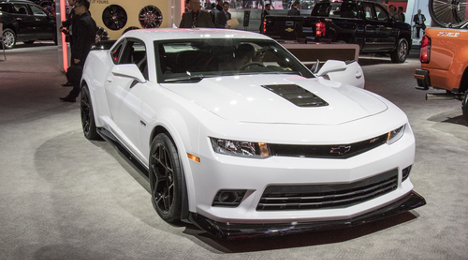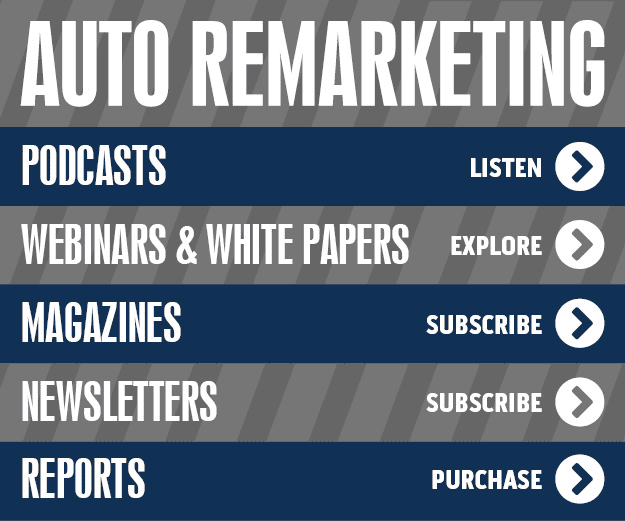CarStory released its monthly Used Vehicle Deal Alert on Wednesday, highlighting the best deals it’s seeing for its customers across the country.
On the reverse side, however, is something particularly useful for dealers: the top five most popular used vehicles searched for on CarStory's site.
Here’s the list, based on online searches by make and model, according to CarStory:
CarStory's Top Five Most-Popular Used Vehicles
- Ford F-150
- Jeep Wrangler
- Ford Mustang
- Cadillac Escalade
- Audi A4
The report from CarStory outlines the best used-vehicle deals it can find around the country that are listed on its site, saying that the average savings across the country comes in at $3,039, or 17 percent per vehicle. The top three were on the Toyota Prius (in Los Angeles), the BMW 5 Series (in Phoenix) and the Mercedes-Benz C-class (also in Los Angeles).
“With so much information out there, finding the best deals on used cars can be challenging for consumers,” said Chad Bockius, the company’s chief marketing officer. “Our CarStory Deal Alerts analyze millions of pieces of pricing data to help consumers cut through the digital noise and save dollars this holiday season, while also giving them a snapshot of what other consumers are searching for.”
After L.A., Philadelphia has the second-highest average discount on used vehicles listed on CarStory.
Brand-by-brand, Mercedes-Benz vehicles are discounted in the most cities (13) according to CarStory, followed by Jeep (11), Nissan (6), Chevrolet (4) and Lexus (4).
For more information on CarStory, visit its site here.
Citing historical trends, NADA Used Car Guide points out that November saw an easing in used-vehicle depreciation, staying the course for the typical seasonal pattern of the industry. November’s depreciation – 1.9 percent – was noticeably lower than October’s 2.7-percent drop.
In the December edition of Guidelines, NADA UCG’s seasonally adjusted used-vehicle price index rose 1 percent compared to last month, to 123.8. Year-to-date, the index falls just 0.2 percent shy of the index’s all-time high averaged last year.
"It's normal for used-vehicle depreciation to slow during the end of the year,” Jonathan Banks, NADA UCG’s executive analyst, said in the analysis. “That said, while the slow is normal for the month, it was steeper than last November's 1-percent slide."
Diving a bit deeper, compact cars saw the biggest hit last month, falling by an industry high 2.7 percent in November, continuing its trend of dropping roughly 3 percent each month for the last seven.
While depreciation for the industry, as a whole, stood at 13.2 percent YTD at the end of November (compared to 12.7 percent for 2014), let’s take a look at all of the segments’ price drops last month, according to NADA UCG:
Change in Wholesale Used-Vehicle Prices – Oct. vs. Nov. 2015
| Segment |
Price Drop Percentage (all values negative) |
| Compact Car |
(2.7) |
| Large Car |
(2.3)
|
| Subcompact Car |
(2.1) |
| Luxury Mid-Size Car |
(2.1) |
| Luxury Compact Car |
(2.0) |
| Industry Average |
(1.9) |
| Mid-Size Van |
(1.9) |
| Luxury Mid-Size Utility |
(1.7) |
| Luxury Compact Utility |
(1.6) |
| Large Pickup |
(1.6) |
| Mid-Size Utility |
(1.6) |
| Compact Utility |
(1.4) |
| Mid-Size Car |
(1.4) |
| Mid-Size Pickup |
(1.1) |
| Luxury Large Car |
(1.1) |
| Large SUV |
(0.8) |
Year-to-date auction volume, by the end of November, stood at 3.83 million units, up 4 percent compared to the same period last year.
Looking forward, NADA UCG predicts that the prices for used vehicles aged zero to 8 years will fall roughly 1 percent in December compared to November. Zooming in to the segment level, the organization also predicts that subcompact and compact cars will drop by 1 percent, more than any other mainstream segment, while both luxury cars and utilities are expected to lose 1 to 1.5 percent in December.
January prices are expected to remain flat before increasing approximately 0.5 percent in February.
Stress-testing has had a profound effect on risk management practices within banks. In the wake of the global financial crisis, regulators around the world instituted policies designed to substantially remove the possibility of large-scale bank failures.
Capital reserves at banks have been appreciably raised, and regulators are applying a considerably greater amount of scrutiny to the way banks monitor and predict risk.
Although stress-testing is a young discipline and will surely change radically over the next decade, the procedures being put in place hold the potential to transform the way financial institutions around the world are managed.
In the form implemented by U.S. regulators, stress-testing involves trying to infer the likely performance of a portfolio assuming that a specific, dire macroeconomic scenario starts to unfold.
Most large banks have active auto loan portfolios. Therefore, a great deal of effort has been applied to the problem of stress-testing default probabilities, credit losses, loan recovery rates, lending volumes, and revenues associated with the management of auto portfolios.
Leases, although rarer in the banking industry, have also demanded increased analytical scrutiny. The shift into leasing has added residual forecasting and return rate probability to the mix of factors to be stress-tested by the auto industry.
The purpose of this article is to consider some of the lessons learned from research conducted to stress-test bank auto portfolios. This is not meant to be a general discussion of stress-testing, per se, but a summary of some elements that are quite unique to the world of auto finance. Auto loans and leases, like mortgages, are secured by collateral.
Unlike property, however, autos are mass produced, depreciating products with a relatively short life span. These features change the way auto loans and leases behave in the context of a downside macroeconomic event.
This article will set out by considering, at a high level, how auto loans tend to perform in recessions. Data for the 2001 and 2008-2009 events will be compared and contrasted with a view toward trying to predict how auto portfolios might be expected to behave in a future recession.
We will consider as part of this discussion the effect of fiscal stimulus packages such as cash for clunkers and whether the auto industry could expect a repeat performance in future recessions. We will conclude by asking whether a subprime-mortgage style crisis could conceivably affect the future auto industry.
Pro and counter cyclicality
The 2001 and 2008-2009 recessions were different beasts. The 2001 event was tamer, having its origins in the dot-com bust and 9/11; the Great Recession was triggered by a banking sector crisis, the likes of which had not been seen since the 1930s. The auto sector, it is safe to say, was not a proximate cause of either event.
The performance of the new-car industry was markedly different in each event. Coming into the 2001 recession, new-car sales were climbing steadily, reaching a peak of close to 19 million annualized units around the turn of the millennium.
As the recession started to bite, generous incentive packages offered to customers, coupled with a strong “nesting” instinct in the wake of 9/11, acted to keep unit sales of new vehicles relatively high. If new-car sales were the only economic indicator you considered, you would be unaware that the 2001 recession even happened.
The Great Recession, by way of contrast, saw new-car sales crater. In early 2009, during the immediate aftermath of the Lehman Brothers collapse, monthly sales fell to around 9 million annualized, barely half the precrisis level. Some attribute the sales decline to problems at GM and Chrysler, and these events certainly did not mitigate against the dire impact of the recession.
It can be noted, though, that unaffected manufacturers also suffered steep reductions in sales. It is fair to say that Toyota and Ford could have sold more to unsatiated GM customers had the demand for their vehicles actually been present in the economy. The new-car industry has been fighting back over the past six years but it took until 2014 before pre-Great Recession sales numbers were observed once more.
Although consumers continued to refresh their vehicles during the 2001 recession, foregoing things such as vacations and international travel for a nicer ride, Great Recession consumers clearly opted to delay the purchase of new or newer vehicles. This had a decidedly negative, deep impact on auto manufacturers and new-car dealers.
For financiers, meanwhile, the recession was a relatively mild, short-lived event. By early 2010, auto default rates were already at prerecession levels.
Recoveries on those loans that were in default were low because used-vehicle prices were rising at breakneck speed. At least one bank in the knowledge of the present author saw recoveries exceed gross credit losses during the latter days of the Great Recession.
It behooves us to ask why the recession was so mild and short for some auto financiers.
The fact that the 2008-2009 recession started in mortgage was, in a roundabout way, a positive for the auto finance industry. With house prices falling rapidly in most parts of the country, consumers’ normal resilience in paying their mortgage through tough times crumbled rapidly.
If we consider delinquency rates on mortgages, car loans and credit cards it becomes immediately clear that, prior to 2009, mortgages consistently had the lowest rate of nonpayment, followed by auto and credit cards in third place.
The subprime crisis led to a huge rise in mortgage delinquency and default, to the point where, by far, mortgage was the most defaulted form of consumer loan (in terms of percent of dollar volume outstanding) by late 2009. With house prices falling, troubled consumers overwhelmingly decided to favor the car loan over the house. You would get terrible gas mileage if you ever tried to drive the house to work.
It turns out that if home foreclosure ever becomes inevitable, it gives consumers an unexpected source of disposable income that can be applied to other loans.
It is a fairly callous form of accounting, but a missed $1,600 mortgage payment represents four $400 car payments or 16 $100 credit card installments for a troubled mortgagee.
The second relevant point is that the decline in new-car sales in late 2008 and early 2009 inevitably led to a dearth of used-car supply in early 2010. This phenomenon is well known in the auto industry, though our view is that the time lapse between new-car sales and the used-car price surge is a fair bit shorter than the view commonly held in the industry. If the dominant form of transaction, for example, is a three-year lease, it might be reasonable to expect the gap between these events to be about 36 months.
The empirical data, however, show that new-car sales lead used-car prices by around 12 to 18 months; this pattern has been consistent over the past few decades. These supply dynamics are overwhelmingly responsible for the surging used-car prices seen in 2010 and the thin losses observed by many in the auto finance sector during the same period.
In a hypothetical future recession, new-car sales is the key variable to track. If sales remain aloft during the recession, financiers and remarketers should brace for a period of low used-car prices about a year after the onset of recession.
If new-car sales crater, however, the industry can take succor in the fact that used-vehicle supply will contract, and prices will rise, thus cushioning the back end of the recessionary period.
Fiscal policy
A short side note relates to the issue of fiscal stimulus during a recession. Whether or not you agree with the concept of the government taking on the role of “spender of last resort” during a deep recession, it is still valid to consider the appropriate form of stimulus should such an intervention ever be deemed necessary.
During the last recession, the auto industry was supported by bailouts of GM and Chrysler and by the $3 billion cash four clunkers scheme that triggered some to update their ancient vehicles during the deepest part of the recession.
The empirical evidence on the success of cash for clunkers is thin. A cynical analyst could line up the 2009 scheme and the 2010 price surge and say that X caused Y.
A less cynical, data-driven person certainly could not reject this assertion; future empiricists may be able to weigh in on the issue of exactly how much of the 2010 price surge was due to cash for clunkers market activity. Equally certainly, we can say that the scheme did not hurt used-car price dynamics during this time.
The Chrysler and GM bailouts were certainly positive for auto industry employment during the recession, though the longer-term effects of the bailouts will likely be highly negative.
Our view is that if fiscal stimulus is to be enacted, the auto industry is an excellent candidate for support. Car use is close to universal in the U.S., and the auto sector employs many millions of Americans across an enormous range of household income levels.
It is difficult to find other industries with better stimulus credentials in terms of progressivity or heavy employment concentration.
The next time recession looms therefore, assuming pro-stimulus legislators are in place, it is completely reasonable to believe that stimulus funds will flow in the direction of the auto sector.
Can it happen to us?
The discussion until now has focused on the effects of externally triggered recessions on the auto industry. History shows that recessions are caused by structural imbalances or bubbles in key sectors of the economy and that economic pain is highest in the sector where the imbalances first appeared. It would therefore be prudent of us to consider the likelihood that the auto industry will be the root cause of the next recession.
As mentioned already, the auto industry is certainly big enough to cause the U.S. economy to topple. Some banks are exposed to auto portfolios that are consequential enough to trigger bank failure. The auto sector, like the mortgage industry, uses securitization in high volume; it was these forces that many blame for the subprime crisis that triggered the Great Recession.
Despite the presence of these preconditions, our view is that an auto-induced recession is highly improbable. One of the commonalities observed in previous financial recessions was the existence of speculative asset price bubbles.
During the 2005-2006 housing boom, for instance, many individuals and companies were buying real estate with zero yield on the expectation of reaping capital gains upon sale of the asset.
House prices, after all, never, ever fall! At a basic level, this form of psycho-pathology is not plausible in the auto sector.
Although it is true that some highly specialized companies exist to arbitrage minor market inconsistencies, most sane people do not expect to make a profit when buying and selling used vehicles unless they happen to be auto dealers. Cars are mass-produced, depreciating assets that do not lend themselves to speculation regarding potential capital gains.
Some may argue that speculation is possible by people operating within the world of asset-backed securities. This is true, but only up to a point.
Someone analyzing a securitized deal could quite easily and accurately determine a theoretical maximum value of the collateral that cannot be breached under any sensible circumstances. If an investor were to pay such a price, or anything remotely similar, they would cease to be investors after a short time.
Given the size of the industry, one does not want to completely rule out the possibility of an auto-caused recession. If such a black swan exists, it is far more likely that the production and manufacturing side of the industry is its natural habitat. The auto-induced recession swan does not swim on the financial side of the lake.
Conclusion
The auto sector has many characteristics that make a subprime-style collapse unlikely.
The shorter half-life of cars relative to houses, the fact that vehicle production can be initiated or called off relatively quickly, that auto markets are inherently non-speculative, and the fact that used-vehicle price dynamics tend to be countercyclical all support the notion that auto recessions are unlikely to linger.
This is not to say that the early days will not be dark—they will be. The evidence, though, suggests that recovery will tend to be robust, ongoing and earlier than that of the rest of the economy.
The broader point is that the onset of bank stress-testing has led to a deeper and clearer understanding of the macro forces acting on the auto industry. Expect future stress tests to yield many interesting insights for auto industry insiders.
Tony Hughes is managing director of credit analytics at Moody’s Analytics.
When it comes to a vehicle’s retained value from new to used, volume is important — but selling more of a vehicle doesn’t necessarily imply its value will stay. Even if the product is spectacular, perceived quality and new quantity sold do not go hand in hand.
This is one lesson that Subaru and Lexus have apparently learned, as both were today named by Kelley Blue Book for the latter’s 2016 Best Resale Value Award winners for best brand and best luxury brand, respectively.
Auto Remarketing chatted with Eric Ibara, KBB’s director of residual values, to see why.
“I guess the simple answer would be that they make great vehicles that people want. There are a lot of brands that make great cars,” Ibara said. “I think what we’ve learned is that making great cars is not sufficient. You also need to manage the way in which vehicles are marketed and sold. And what these brands do very well, I think, is they match their production with the market demands.
“They don’t overproduce the vehicles, and they’re also marketing the vehicles in a way that enhances the value of the vehicles. So they’re not discounting their vehicles to get more volume.”
KBB's 2016 Best Resale Value: Top 10 Cars
| Chevrolet Camaro |
Subaru Forester |
| Chevrolet Colorado |
Subaru WRX |
| GMC Canyon |
Toyota 4Runner |
| GMC Sierra |
Toyota Tacoma |
| Jeep Wrangler |
Toyota Tundra |
And if you take a look at the top-10 list of vehicles from the 2016 model year that KBB expects to retain the highest percentage of their sticker values, you probably won’t be surprised that eight out of the 10 are trucks or utility vehicles. What may surprise you, however, is that five of the vehicles expected to depreciate the least are from domestic automakers.
With four of those five being manufactured by General Motors, we asked Ibara if he was surprised.
“I think that people could be surprised by that. You don’t normally think of domestic brands when you think of vehicles that retain their value,” he said. “But I think that ever since GM went through bankruptcy they really have changed the way in which they approach the market. I sense, and I see, that they’re doing a better job of matching production to demand. They’re not overproducing vehicles and they’ve cut back on the volume of vehicles that they send into daily rental.
“I think these are all good signs but I guess, first and foremost, they’re making vehicles that are very appealing when you see the vehicles that have come to market over the last few years, like the Tahoe and like the Canyon and Colorado,” he continued. “You can see that the vehicles are much improved over what they’ve offered in the past.”
Those with a keen eye that follow KBB’s resale values will notice a first-time inclusion on the list: Tesla.
Ibara says that used-car transaction data for Tesla, up until recent times, was a bit hard to come by. But now that the situation has been rectified, as Ibara put it, KBB is noticing that Tesla’s Model S isn’t seeing as hard a hit in the used market as the rest of the electric vehicle segment is currently experiencing.
“The electric vehicle segment is very interesting,” Ibara said. “We are seeing EVs depreciate much faster than their gasoline-engine counterparts, where one exists. We think it’s a function of the federal tax credit that all these vehicles qualify for and we also think that the early adopters who are buying the electric vehicles want a new car. We don’t see a lot of early adopters gravitating toward used electric vehicles and as a result their depreciation is very steep, for the most part. The Model S is an exception to this rule.”
So what’s a “safe” segment to invest in, as a used-vehicle dealer? KBB expects for trucks and sport utility vehicles to remain popular for years to come — a trend that Ibara says started before oil prices dropped the favorable level they are today.
“We think it’s a trend that will be around for a while,” he said. “Oil is trading around $35 a barrel right now, and there’s really no sign that it’s going to end that streak any time soon. We’re thinking that consumers will continue to prefer sport utility vehicles and that will make them more desirable five years down the road.”
Here's the full list of KBB's 2016 Best Resale Value Awards by vehicle category:
KBB's 2016 Best Resale Value: By Vehicle Category
| SUBCOMPACT CAR: Honda Fit |
PLUG-IN VEHICLE: Tesla Model S |
| COMPACT CAR: Subaru Impreza |
COMPACT SUV/CROSSOVER: Jeep Wrangler |
| SPORTY COMPACT CAR: Subaru WRX |
MID-SIZE SUV/CROSSOVER: Toyota 4Runner |
| MID-SIZE CAR: Subaru Legacy |
FULL-SIZE SUV/CROSSOVER: Chevrolet Tahoe |
| FULL-SIZE CAR: Toyota Avalon |
LUXURY COMPACT SUV/CROSSOVER: Porsche Macan |
| ENTRY-LEVEL LUXURY CAR: Lexus RC |
LUXURY MID-SIZE SUV/CROSSOVER: Lexus GX 460 |
| LUXURY CAR: Lexus GS |
LUXURY FULL-SIZE SUV/CROSSOVER: Lexus LX 570 |
| HIGH-END LUXURY CAR: Porsche Panamera |
HYBRID SUV/CROSSOVER: Lexus RX 450h |
| SPORTS CAR: Chevrolet Camaro LT |
MID-SIZE PICKUP TRUCK: Toyota Tacoma |
| HIGH PERFORMANCE CAR: Chevrolet Camaro SS |
FULL-SIZE PICKUP TRUCK: Toyota Tundra |
| HYBRID/ALTERNATIVE ENERGY CAR: Lexus ES 300h |
MINIVAN/VAN: Toyota Sienna |
VehicleXchange LLC announced Monday that it has added automated GM Financial pre-qualification capabilities to its service lane lead solution.
The tool, launched by Pearl Technology Holdings in January and otherwise known as “VX,” now allows dealers to pre-qualify customers through GM Financial within seconds.
The VX system utilizes pre-screening technology from Experian to allow dealers to calculate a customer’s equity in their vehicle as well as allowing consumers to view all vehicles in a dealer’s inventory that they are pre-qualified to purchase.
Another aim of VX is to help customers find “improved” terms via manufacturer incentives and estimated payments, allowing customers to upgrade their vehicle and maintain the same or lower monthly payments.
Allowing for automatic communication to consumers on the dealer’s behalf, the VX system can turn manufacturer incentives into targeted marketing campaigns within 24 hours of release.
The solution has achieved 1,300 subscriptions from dealers since it launched at the beginning of the year. To learn more about VX, click here.
Looking back on November’s wholesale results, the picture painted is very much similar to previous months: Average auction prices were up month-over-month but flat year-over-year. And the uptick was largely due to truck prices.
Wholesale vehicle prices in November averaged $9,883, an increase of 1.1 percent compared to October. This was 0.1 percent higher than year-ago figures.
This was reflected in ADESA Analytical Services’ monthly analysis, provided by Tom Kontos, who pointed out in his Kontos Kommentary that the “strong retail demand,” especially in the certified pre-owned area, is what is maintaining the price levels despite the increasing supply.
“In short, data and other analysts are increasingly validating comments made here for many months about inevitable price softness from growing used-vehicle supply,” Kontos said. “Also as noted repeatedly here, the major saving grace keeping prices from falling further and sooner has been strong retail demand, especially for certified pre-owned vehicles.”
Kontos also pointed out that the softer pricing conditions are hitting institutional consigners more than dealers, “who have the option of retailing vehicles and only wholesaling units for which they can obtain attractive sales prices.” He said this advantage was show via strong month-over-month and year-over-year auction performance for dealer consignors.
To that end, the results for November show that the average wholesale prices for used vehicles remarketed by manufacturers were up 3.1 percent month-over-month and 4.3 percent year-over-year — and Kontos drew attention to the fact that, “manufacturers held out for their asking prices by often selling less than 50 percent of the units offered.”
Looking at vehicles in the 3-year-old segment, which Kontos used as a proxy to represent off-lease vehicles, the prices were down 3.2 percent month-over-month in November, and 9 percent year-over-year.
Utilizing data provided by NADA, Kontos showed that used-vehicle sales by franchised dealers increased 4.1 percent year-over-year while independent dealers saw their sales increase by 5.4 percent, both of which were down month-over-month.
According to figures from Autodata, CPO sales decreased by 13.8 percent month-over-month in November and 4.7 percent on a year-over-year basis. Despite that drop, overall sales remain up 8.7 percent year-to-date.
A new online vehicle broker service has recently hit the Web, and the inspiration for the new company stemmed from frustration with the current car-buying process.
KosLo’s chief executive officer and founder Devin Koskan may not have a background in the auto industry — but he has, of course, purchased vehicles before, which helped spark the idea for his newest endeavor.
KosLo works to connect dealers with shoppers from across the country by receiving shopper requests and allowing participating dealers that have the vehicle the customers wants to bid for their business.
“The project came from the frustration with the buying process, the time it took, the time you had to invest in going to multiple dealerships, time spent searching online and more,” said Koskan. “I would always go to Google and search for the best site to find a deal on a vehicle, and I knew that I was only seeing what certain venders were listing on that site, and for dealerships, I was obviously only seeing what they had right there.”
He wanted to come up with a tool that could reach the entire country and give customers negotiating power that they didn’t necessarily have when visiting one site or just a few dealerships.
“If I was only buying one vehicle I had no negotiating power — of course, if I was buying hundreds of vehicles, now I could get a better price, but I knew as an individual, I was not able to get a better price,” Koskan shared. “I always felt like even if I found a car I liked, I didn’t know if it was the best deal I could have found.”
So KosLo was born in an effort to create a system that allows dealers to broaden their market reach, as well as give consumers more buying power and save them time.
Bidding for business
When dealerships sign up with KosLo, they tell the site what brand of vehicles they sell. Then, the process begins with a customer keying in exactly what vehicle they want.
Take a 2015 Chevrolet Silverado, for example. If KosLo has 100 Chevy vendors listed in their system, when they get a bid from a customer in the market for a Chevy, the system sends out bid requests to all 100 of those Chevy dealerships, giving them the specifics of what the customer is looking for. And from there, dealerships bid for the business by sending KosLo their best price on that vehicle.
The system then takes the top 20 prices that meet the customer’s criteria and negotiates freight price on those vehicles from wherever the bid came from to the customer’s doorstep. The customer is then given the top five vehicle bids based on dealer price plus shipping cost.
After the customer chooses, the dealer will receive a confirmation code indicating the buyer's acceptance of their deal, and works directly with the buyer to finalize the sale.
“There is a competition aspect, where venders are having to give the best price they can because they know they are bidding against people across the country,” Koskan said.
“It changes the game in the fact that a customer doesn’t have to go to the dealership. A lot of dealerships have gone to no-haggle pricing models, so you go there and that price you see is what you are paying,” he continued. “It turns the tides in that a customer doesn’t have to accept that local dealership price. It gives them that negotiation power, and it saves them so much time.”
Benefits for dealers
Though the tool has the potential to assist consumers in their car-shopping process, Koskan was quick to point out the benefits for dealers, as well.
First, dealers normally have to list their inventory on third-party sites online, and connecting with these systems can be costly, and of course, the dealer has to regularly maintain these listings, as well.
“With our system, vendors don’t have to do anything or pay to link with us. They just have to be willing to bid when we send them a request,” Koskan said.
Secondly, he pointed out participating dealers might be able to scale back their marketing campaigns long-term.
“They spend hundreds of thousands of dollars doing ads on TV, in print, on the radio, just trying to reach people that have all these other choices in a local market,” said Koskan. “Now, we will be bringing leads to them from across the country, not just their local market.”
Finally, through KosLo, dealers are receiving qualified leads and not paying $50 to $100 per click on their items advertised online.
“Say, a customer clicks on their item online, they pay, where our service is they give us our best price, and we give the customer the top five prices, and it’s not until the customer picks the exact one that they want that a vendor has to pay anything for the lead,” Koskan said.
Though it isn’t a guaranteed lead, “the customer has done the research, has looked through the top five cars that we have found across the country, so it’s a pretty sure deal that they will complete the sale,” Koskan explained.
Dealer response has been great so far from the 20 dealers currently on board, Koskan said. And the company is currently in the middle of a vendor campaign to attract more dealers.
“It’s just a matter of continuing our marketing campaign and actually having the conversation with vendors to explain the benefits we bring to not only their customers, but to them,” he said.
For more information and to register for KosLo, dealers can visit https://koslo.com/business-opportunities/ or https://koslo.com/partnership/.
Larry H. Miller Dealerships announced several high-profile changes to its executive-level structure this week, including the hiring of a new vice president and two internal promotions in the area of search engine marketing and optimization.
Starting with the hire, on Monday LHM announced Veronika Egginton as its new vice president of digital development, where she will be responsible for overseeing the digital marketing department for LHM’s 54 stores. She will also be responsible for defining the digital strategy for each store and ensuring proper execution of all deliverables through her team.
Paul Nygaard, senior vice president of marketing LHM Dealerships, made the hiring announcements.
“Veronika’s vast industry experience and her process-driven approach to digital marketing will be valuable as she leads digital strategy for our group,” Nygaard said. “There are an abundance of innovative products available in the automotive industry, and having the ability to navigate, implement and track the success of these products is essential in this role.”
Egginton’s previous experience in the automotive landscape includes a variety of positions with Fiat Chrysler Automobiles, where she served as an area sales manager for the Fiat/Alfa Romeo West Business Center, the Jeep incentive and events marketing manager and digital marketing manager in Phoenix, as well as the manager of digital media optimization for FCA US in Auburn Hills, Mich.
She also spent several years as an account manager for Microsoft, focusing on the Ford Motor Company and General Motors accounts. Egginton also managed accounts with Lufthansa, Red Bull, and Citibank for the WPP Group in both Dearborn, Mich., and Frankfurt, Germany.
She attended the Ludwig Erhard Business School in Karlsruhe, Germany, and the German Academy of Direct Marketing in Frankfurt.
Nygaard also announced the promotion of Doug Peterson and Taylor Christensen, who will take on the positions of director of search engine marketing and director of search engine optimization, respectively.
“Doug and Taylor have each proven to be strong leaders and skilled marketers and I look forward to their continued growth and leadership in their new roles," Nygaard said.
Petersen previously held the position of digital marketing manager for LHM Dealerships. Before joining LHM, he held a variety of management positions with the Ken Garff Automotive Group. Petersen graduated from Utah Valley University in Orem, Utah with a bachelor’s degree in business administration and management.
Christensen, LHM’s new director of search engine optimization, previously served as the company’s digital marketing manager, providing SEO and SEM strategy and services for dealerships in Colorado and New Mexico. He also previously spent time with the Ken Garff Automotive Group, serving as the digital media manager as well as a marketing analyst for Eagle Gate College. Christensen graduated from the University of Utah with a bachelor’s degree in marketing.
For more information about LHM Dealerships, visit its site here.
Chrome Data Solutions, in partnership with SpinCar, have collaborated to create a 360-degree vehicle rotation platform to enhance vehicle description pages.
Perhaps the most striking feature that differentiates the tool from other similar offerings is the inclusion of “hot spots,” which allow the seller to highlight features of each vehicle and provide the customer another way to learn about the vehicle and interact with the VDP.
"SpinCar has a track record of bringing high-performing merchandising solutions to the automotive space,” said Devin Daly, SpinCar’s chief executive officer. “With the help of Chrome Data's reputation and network of industry partners, we will be able to deliver these solutions at scale much more easily and quickly. This will have a powerful impact on dealership leads and sales.”
Through the partnership, Chrome Data and SpinCar will provide two new dealership products, as described below by the companies:
- Stock Image Gallery Tool leverages Chrome Data's comprehensive library of stock imagery along with SpinCar's proprietary merchandising technology to give portals, resellers, and dealers a state-of-the-art way to show off their unique vehicles, via interactive 360-degree interior/exterior views and hotspots, while gathering unprecedented user interaction data.
- Dealer Inventory Image Tool allows dealers to showcase actual inventory in an engaging and interactive way, and take advantage of a solution which has had impressive success in the automotive space after a strong beginning in retail ecommerce.
"SpinCar offers a best-of-breed merchandising solution that has incredible impact on website performance," said Andrew Lumsden, vice president of Chrome Data’s Product and IP Licensing Group. "We're excited to combine proven SpinCar technology with our industry-leading images to give dealers a solution that truly captures the in-store experience for online shoppers."
Dealers, have you had to try to fit cars, car or auto into your URLs, perhaps producing an unwieldy or hard-to-remember Web address?
Well, the latest announcement from Cars Registry — a joint venture between domain companies XYZ and Unregistry — might come in handy, then.
The team at Cars Registry announced on Wednesday the availability of three new domain extensions: .Cars, .Car and .Auto.
To start off, between Dec. 9 and Jan. 12, the domains will be first made available to trademark holders registered in the company’s Trademark Clearinghouse.
Following this trademark period, a public priority registration period will start on Jan. 12 to give anyone an opportunity to register any available domains for a premium fee before they enter general availability.
And then on Jan. 20, the domains will become open to the public through Cars Registry’s retailers, including Network Solutions and GoDaddy.
The new extensions can potentially give auto companies and dealerships a marketing advantage over what are often expensive or lengthy .com URLs, the company shared.
“With nearly 300 million domain names registered worldwide, it is increasingly difficult for businesses to find short memorable domains,” said Daniel Negari, chief executive officer of Cars Registry.
Cars Registry management explained the new domain extensions can lead to auto companies securing digital real estate that is “shorter, more memorable and more relevant to their online presence.”
Take this early adopter, for example. Luxury car dealer St. Louis Motorcars upgraded its Web presence from STLMotorcars.com to STL.Cars. Keep in mind, shorter URLs are much more mobile-friendly, and every year more and more car shoppers are using their smartphones to search for their next vehicle.
“I can't think of a better or clearer domain name for my dealership than STL.Cars," said St. Louis Motorcars dealership principal Graham Hill. "Buying the .com version of STL would have cost hundreds of thousands of dollars, and STL.Cars works exactly the same way but looks better in advertising. I got a better looking name for a fraction of the price.”
Cars Registry will also be providing complimentary services to dealerships to help them transition their websites and new domains, in an effort to maximize SEO benefits.
“Two letter and three letter .com domains are 100 percent registered, and can re-sell for hundreds of thousands and, in some cases, millions of dollars on the secondary market. On the other hand, all .Cars, .Car and .Auto domains will cost the same standard registration fee,” said Negari. “This represents the first and last expansion in automotive naming. Businesses of all types, from dealerships to manufacturers, can now establish an authoritative Web presence using .Cars, .Car and .Auto domains to drive their brand.”
To learn more about the new domains, visit http://www.Go.Cars.












